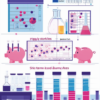
Optimizing Processing Costs in Cord Blood Banking
Streamlining Cord Blood Banking Processes for Cost Optimization
Cord blood banking has become an increasingly popular option for parents looking to preserve their child’s stem cells for potential future medical use. However, the costs associated with this process can be a significant barrier for many families. Fortunately, there are strategies that cord blood banks can implement to optimize their processing costs, making the service more accessible and affordable.
Automation and Efficient Workflows
One of the primary ways to reduce processing costs in cord blood banking is by automating various aspects of the workflow. Automated systems can handle tasks such as sample processing, labeling, and storage, reducing the need for manual labor and ensuring consistency in procedures. This not only streamlines the overall process but also minimizes the risk of human error, leading to more efficient and cost-effective operations.
Optimizing Facility Design and Infrastructure
The design and infrastructure of the cord blood banking facility can also have a significant impact on processing costs. By carefully planning the layout and leveraging cutting-edge technologies, banks can maximize the use of available space, reduce energy consumption, and optimize the flow of materials and personnel. This can result in significant cost savings, particularly in areas such as rent, utilities, and maintenance.
Leveraging Economies of Scale
As the demand for cord blood banking services grows, cord blood banks have the opportunity to benefit from economies of scale. By processing larger volumes of samples, banks can spread their fixed costs over a greater number of units, leading to a lower cost per unit. This can be achieved by expanding their client base, partnering with healthcare providers, or exploring opportunities for regional or national collaboration.
Streamlining Logistics and Supply Chain Management
Effective logistics and supply chain management are crucial for controlling processing costs in cord blood banking. This includes optimizing the procurement of supplies, transportation of samples, and the management of inventory. By leveraging data-driven insights, cord blood banks can identify and address inefficiencies, minimize waste, and ensure that resources are utilized effectively.
Enhancing Quality Control and Compliance
Maintaining high-quality standards and compliance with industry regulations is essential for cord blood banking, but it can also contribute to increased processing costs. By implementing robust quality control measures and streamlining compliance processes, banks can reduce the resources needed for these tasks while still ensuring the safety and efficacy of their services.
Leveraging Technology and Innovation
The cord blood banking industry is constantly evolving, and staying up-to-date with the latest technological advancements can be a significant factor in optimizing processing costs. From adopting automated systems to implementing cloud-based data management solutions, cord blood banks can leverage technology to improve efficiency, reduce manual labor, and enhance overall operational performance.
Continuous Process Improvement
Cord blood banks should embrace a culture of continuous process improvement. By regularly reviewing their operations, identifying areas for optimization, and implementing data-driven changes, banks can continuously refine their processes and reduce processing costs over time. This iterative approach, combined with the strategies outlined above, can help cord blood banks achieve greater cost efficiency and make their services more accessible to a broader range of families.
Strategies for Reducing Operational Expenses in Cord Blood Storage
Streamlining Inventory Management
Effective inventory management is a critical component in optimizing operational costs for cord blood storage facilities. By closely monitoring and managing inventory levels, you can minimize the risk of overstocking or stockouts, both of which can contribute to increased expenses. Utilize data-driven forecasting models to accurately predict demand and adjust storage capacities accordingly. Additionally, consider implementing just-in-time (JIT) inventory techniques to reduce the need for extensive storage space and associated costs.
Leveraging Technology for Process Automation
Embracing technological solutions can significantly enhance operational efficiency and drive down costs in cord blood storage. Automate routine tasks, such as sample tracking, inventory management, and temperature monitoring, using specialized software and cloud-based platforms. Automation not only reduces the time and labor required for these activities but also minimizes the risk of human error, leading to improved accuracy and compliance.
Optimizing Energy Consumption
Energy costs can be a significant contributor to the overall operational expenses of cord blood storage facilities. Implement energy-efficient practices and technologies to reduce your energy consumption. This may include upgrading to energy-efficient refrigeration and freezer systems, optimizing lighting and HVAC systems, and exploring renewable energy sources, such as solar panels, to power your operations.
Streamlining Workflow Processes
Carefully examine your existing workflow processes and identify areas for improvement. Streamline procedures, eliminate redundancies, and optimize the flow of operations to enhance productivity and reduce waste. This may involve implementing lean manufacturing principles, cross-training employees, and establishing clear protocols for sample handling and storage.
Outsourcing Non-Core Activities
Evaluate the feasibility of outsourcing non-core activities to specialized service providers. This can include tasks such as transportation, sample processing, and maintenance of equipment. By outsourcing these functions, you can leverage the expertise and economies of scale of third-party providers, potentially leading to cost savings and improved service quality.
Negotiating Supplier Contracts
Regularly review and renegotiate contracts with suppliers, service providers, and vendors to ensure that you are obtaining the best possible terms and pricing. Stay informed about industry trends and benchmark your costs against competitors or industry standards. This proactive approach can help you secure more favorable agreements and reduce overall operational expenses.
Optimizing Facility Design and Layout
The design and layout of your cord blood storage facility can have a significant impact on operational costs. Carefully consider factors such as storage density, workflow efficiency, and energy consumption when planning or renovating your facility. Collaborate with experts in facility design and engineering to identify opportunities for optimization and cost savings.
Exploring Collaborative Opportunities
Investigate collaborative opportunities with other cord blood storage providers or industry partners. This may involve shared storage facilities, joint procurement initiatives, or the development of centralized processing and distribution hubs. By leveraging economies of scale and shared resources, you can potentially reduce individual operational costs.
By implementing these strategies, cord blood storage facilities can enhance their operational efficiency, reduce costs, and ensure the long-term sustainability of their services. Continuous evaluation and adaptation of these practices will be crucial as the industry evolves and new technologies emerge.
Innovative Approaches to Enhancing Efficiency in Cord Blood Processing
Streamlining Cord Blood Processing Operations
Cord blood banking has become an essential component of modern healthcare, providing a valuable source of stem cells for various therapeutic applications. As the industry continues to grow, the optimization of processing costs has emerged as a critical factor in ensuring the long-term sustainability and accessibility of these services. Innovative approaches to enhancing efficiency in cord blood processing can significantly impact the overall cost structure, benefiting both providers and patients.
Automation and Process Optimization
One of the key strategies for optimizing processing costs in cord blood banking is the implementation of automation and process optimization. By leveraging advanced technologies, such as robotic systems and automated processing equipment, cord blood banks can streamline their operations, reduce manual labor, and improve the consistency and reliability of the processing workflow. This not only enhances efficiency but also minimizes the risk of human error, leading to improved product quality and reduced wastage.
Inventory Management and Optimization
Effective inventory management is another crucial aspect of optimizing processing costs in cord blood banking. By implementing advanced inventory tracking and optimization systems, cord blood banks can better manage their storage capacity, minimize waste, and ensure the timely utilization of collected units. This can involve the use of data analytics, predictive modeling, and strategic inventory planning to optimize storage space, reduce holding costs, and improve the overall efficiency of the supply chain.
Logistics and Transportation Optimization
The logistics and transportation of cord blood units play a significant role in processing costs. Innovative approaches to route optimization, supply chain management, and transportation modes can result in substantial cost savings. Cord blood banks can leverage technologies such as GPS tracking, fleet management software, and real-time data analytics to streamline their logistics operations, reduce fuel consumption, and minimize the carbon footprint of their transportation activities.
Economies of Scale and Collaborative Partnerships
As the cord blood banking industry continues to grow, the potential for achieving economies of scale becomes more apparent. By exploring collaborative partnerships and consolidation opportunities, cord blood banks can benefit from increased operational efficiency, shared resources, and the ability to leverage their collective bargaining power. This can lead to reduced procurement costs, optimized resource utilization, and the implementation of best practices across the industry.
Continuous Improvement and Innovation
Fostering a culture of continuous improvement and innovation is crucial for the long-term optimization of processing costs in cord blood banking. Cord blood banks should prioritize the exploration of new technologies, the implementation of lean manufacturing principles, and the adoption of data-driven decision-making processes. By continuously evaluating and refining their operations, they can identify and address inefficiencies, implement cost-saving measures, and stay ahead of industry trends and evolving customer demands.
The optimization of processing costs in cord blood banking is a multifaceted challenge that requires a strategic and innovative approach. By leveraging automation, inventory management, logistics optimization, economies of scale, and a culture of continuous improvement, cord blood banks can enhance their operational efficiency, reduce overall costs, and ensure the long-term sustainability of their services. These innovative approaches not only benefit the providers but also contribute to the broader accessibility and affordability of cord blood banking for patients and the healthcare system as a whole.
Data-Driven Decision Making for Optimized Cord Blood Banking Costs
Streamlining Operational Efficiency for Cost-Effective Cord Blood Banking
The cord blood banking industry has experienced significant growth in recent years, driven by the increasing recognition of the therapeutic potential of stem cells derived from umbilical cord blood. However, as the industry matures, the need for optimizing processing costs has become increasingly crucial to ensure the long-term sustainability and accessibility of this valuable healthcare service.
Leveraging Data Analytics for Informed Decision Making
In the quest to optimize processing costs, data-driven decision making has emerged as a powerful tool. By harnessing the wealth of data generated throughout the cord blood banking process, industry leaders can gain valuable insights that inform strategic decisions and drive operational efficiency.
One key area where data analytics can make a significant impact is in the optimization of laboratory workflows. By analyzing historical data on sample processing times, resource utilization, and inventory management, cord blood banking facilities can identify bottlenecks, streamline processes, and allocate resources more effectively. This can lead to reduced labor costs, improved productivity, and enhanced operational agility.
Leveraging Automation and Technological Advancements
In addition to data-driven decision making, the integration of automation and technological advancements can also play a crucial role in optimizing processing costs. Automated systems for sample processing, storage, and retrieval can significantly reduce the reliance on manual labor, leading to cost savings and improved accuracy.
Moreover, the integration of cutting-edge technologies, such as cloud-based storage solutions and advanced data management platforms, can enhance the efficiency of record-keeping, inventory management, and reporting. By streamlining these administrative tasks, cord blood banking facilities can redirect resources towards core operational activities, ultimately driving down processing costs.
Another strategic approach to optimizing processing costs in the cord blood banking industry is the fostering of collaborative partnerships and the sharing of resources. By leveraging economies of scale and collaborative efforts, cord blood banking facilities can achieve cost reductions through the joint procurement of equipment, shared laboratory space, and the pooling of administrative resources.
Furthermore, the establishment of industry-wide initiatives and standardized protocols can facilitate the sharing of best practices and the adoption of innovative cost-saving measures. This collaborative approach not only benefits individual cord blood banking facilities but also strengthens the industry as a whole, ensuring the long-term viability and accessibility of this crucial healthcare service.
Continuous Improvement and Adaptation
In the dynamic landscape of the cord blood banking industry, a commitment to continuous improvement and adaptation is essential for sustaining cost optimization efforts. Cord blood banking facilities must remain vigilant in monitoring industry trends, technological advancements, and regulatory changes, and be willing to adapt their strategies and processes accordingly.
By embracing a culture of continuous improvement, cord blood banking facilities can stay ahead of the curve, anticipate and mitigate emerging challenges, and ensure that their processing costs remain competitive and aligned with the evolving needs of the industry and its stakeholders.
The optimization of processing costs in the cord blood banking industry is a multifaceted endeavor that requires a strategic and data-driven approach. By leveraging data analytics, embracing automation and technological advancements, fostering collaborative partnerships, and maintaining a commitment to continuous improvement, cord blood banking facilities can enhance their operational efficiency, reduce costs, and ultimately ensure the long-term sustainability and accessibility of this essential healthcare service.
Emerging Trends and Technologies in Cost-Effective Cord Blood Management
Optimizing Cord Blood Handling Costs: Embracing Emerging Trends and Technologies
The world of cord blood banking has witnessed a remarkable evolution, driven by the need to make the process more cost-effective and efficient. As the demand for cord blood stem cell therapies continues to grow, healthcare providers and cord blood banks are actively exploring innovative strategies to optimize processing costs while maintaining the highest standards of quality and safety.
Leveraging Automation and Robotics
One of the key trends in cost-effective cord blood management is the integration of automation and robotics. Automated systems have revolutionized the processing and storage of cord blood, reducing the need for manual labor and minimizing the risk of human error. These advanced technologies streamline various stages of the cord blood banking process, from collection and processing to storage and retrieval. By automating repetitive tasks, cord blood banks can significantly improve efficiency, reduce overhead costs, and enhance the consistency of their operations.
Optimizing Storage Solutions
The cost of long-term storage is a significant factor in the overall expenses associated with cord blood banking. Innovative storage solutions, such as the use of cryogenic freezers and ultra-low temperature chambers, have emerged as effective strategies to minimize storage costs without compromising the integrity of the stored samples. These advanced storage systems not only reduce energy consumption but also provide enhanced security and redundancy, ensuring the safe preservation of valuable cord blood units.
Leveraging Cloud-Based Data Management
The adoption of cloud-based data management systems has become increasingly prevalent in the cord blood banking industry. By transitioning from traditional on-premise data storage to cloud-based solutions, cord blood banks can benefit from improved data accessibility, enhanced security, and reduced infrastructure costs. Cloud-based platforms enable seamless collaboration, real-time data updates, and secure access to cord blood records, ultimately streamlining the overall management process and reducing the associated expenses.
Optimizing Logistical Processes
Efficient logistical processes are crucial in maintaining cost-effective cord blood banking operations. Cord blood banks are exploring innovative transportation and logistics solutions to minimize shipping and distribution costs. This includes the use of specialized containers, optimized routing, and collaborative partnerships with logistics providers to ensure the timely and cost-effective delivery of cord blood units to healthcare facilities and patients in need.
Embracing Emerging Technologies
Emerging technologies, such as blockchain and artificial intelligence (AI), are also transforming the cord blood banking industry. Blockchain-based systems can enhance the traceability and security of cord blood samples, while AI-powered analytics can optimize various aspects of the banking process, from sample processing to inventory management. These cutting-edge technologies hold the potential to further drive down costs and improve the overall efficiency of cord blood banking operations.
Fostering Partnerships and Collaborations
Cord blood banks are increasingly recognizing the value of strategic partnerships and collaborations to achieve cost-effective operations. By partnering with research institutions, healthcare providers, and other industry stakeholders, cord blood banks can leverage shared resources, expertise, and economies of scale to reduce costs and enhance the accessibility of cord blood stem cell therapies.
The optimization of processing costs in cord blood banking is a critical challenge that the industry is actively addressing. By embracing emerging trends and technologies, cord blood banks can streamline their operations, enhance efficiency, and ultimately make cord blood stem cell therapies more accessible and affordable for patients in need. As the demand for these life-saving treatments continues to grow, the industry’s commitment to cost-effective cord blood management will be a key driver in shaping the future of regenerative medicine.
Conclusion
Optimization of Processing Costs in Cord Blood Banking: Strategies for a Sustainable Future
In the dynamic and rapidly evolving landscape of cord blood banking, the optimization of processing costs has become a critical factor in ensuring the long-term viability and accessibility of this valuable medical resource. By implementing strategic approaches to streamline operations, embrace innovative technologies, and leverage data-driven decision-making, cord blood banking organizations can navigate the challenges of maintaining cost-effective services while upholding the highest standards of quality and patient care.
One of the primary avenues for reducing operational expenses in cord blood storage is the implementation of efficient processing strategies. Innovative approaches, such as the utilization of automated processing systems and the optimization of handling protocols, can significantly decrease labor-intensive manual tasks and minimize the risk of human error. By automating repetitive procedures and optimizing workflow, cord blood banks can enhance throughput, reduce processing times, and ultimately lower the overall costs associated with maintaining their storage facilities.
Furthermore, the strategic application of data-driven decision-making can unlock tremendous opportunities for cost optimization in cord blood banking. By leveraging advanced analytics and predictive modeling, industry players can gain valuable insights into their operational efficiency, identify areas for improvement, and make informed, data-backed decisions that drive cost savings. This data-centric approach allows cord blood banks to allocate resources more effectively, streamline their logistical operations, and optimize their inventory management, all while maintaining the highest standards of quality and safety.
Emerging trends and technologies in the cord blood banking sector present additional avenues for enhancing cost-effectiveness. The integration of cloud-based storage solutions, for instance, can eliminate the need for on-site infrastructure and reduce the capital expenditure associated with maintaining physical data centers. Similarly, the adoption of blockchain-based traceability systems can enhance transparency, improve supply chain efficiencies, and mitigate the risks of manual errors, all of which contribute to overall cost optimization.
As the demand for cord blood banking services continues to grow, the need for sustainable and cost-effective solutions becomes increasingly paramount. By embracing a holistic approach that encompasses operational optimization, data-driven decision-making, and the strategic implementation of innovative technologies, cord blood banking organizations can chart a path towards a future marked by increased accessibility, affordability, and long-term viability.
The optimization of processing costs in cord blood banking is a multifaceted endeavor that requires a comprehensive understanding of the industry’s challenges and a willingness to adapt to the evolving landscape. By adopting a strategic mindset and leveraging the power of data-driven insights and emerging technologies, cord blood banking providers can unlock new avenues for cost optimization, ensuring that this vital medical resource remains accessible to those in need for generations to come.











